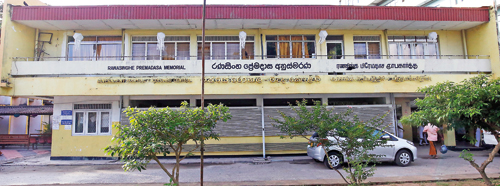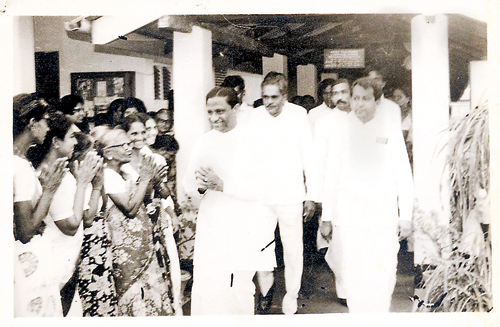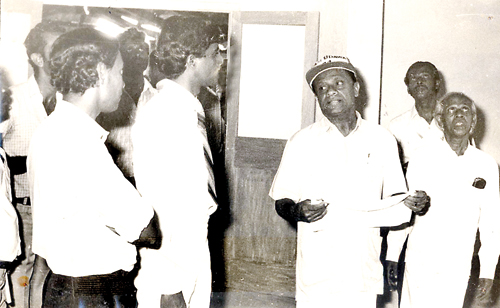A matter of detail

The Ranasinghe Premadasa Memorial Hospital. Pic by M.A. Pushpa Kumara
The tiny things, the little detail, mattered immensely to him.
As the birth anniversary on June 23 of ‘people’s politician’ Ranasinghe Premadasa passes once again, a senior medical administrator flips back the pages of time and recalls his “encounters” with him as a young doctor.
Mr. Premadasa who was killed in a May Day bomb blast 25 years ago, was the Prime Minister back in 1980 when Dr. S. Terrence G.R. de Silva was entrusted with the duties of the Medical Officer-in-Charge of the small Colombo Central Government Hospital at Maligawatte.
It was with some trepidation that Dr. de Silva had taken up the post, knowing full well that the hospital boasting only of an Outpatients Department (OPD), a Maternity Ward and a Dental Unit sited on a four-acre block was in the electorate of Mr. Premadasa, in close proximity to the Ruby cinema. For, a frequent ‘surprise’ visitor was the PM.
Rumour had it that if all was not right during his visits to the hospital catering to people from Maligawatte and its environs as well as Wellampitiya, Mr. Premadasa would fly into a rage, pointing an accusing finger at whoever was running the place.
For Dr. de Silva, however, the “brushes” with Premier Premadasa, who later became President, were an intense learning experience, which guided him to be an efficient administrator, reaching top positions in his career. After Maligawatte, Dr. de Silva went on to become the Director of the Ragama Hospital, followed by the National Hospital and then Deputy Director-General of Medical Services at the Health Ministry and lastly Registrar of the Sri Lanka Medical Council (SLMC).
“Premier Premadasa was a frequent visitor to the hospital because Maligawatte was the centre point from which rippled forth his far-thinking housing schemes, blossoming across the country,” says Dr. de Silva.

People greet the then Prime Minister Ranasinghe Premadasa during a visit to the Maligawatte Hospital in the early 1980s
A weathered plaque captured by the Sunday Times photographer this week proudly announces: ‘Maligawatte Development Scheme, Hospital Stage 1 – This foundation stone was laid by the Hon. E.L. Senanayake, MP, Minister of Health at the invitation of Mr. R. Premadasa, MP, Junior Minister of Local Government’ dated 30.6.1968.
The PM had a local office close to the hospital. There were a few housing blocks. It was marshland, a hotspot for thieves and drug addicts which Mr. Premadasa turned into Phase I of his housing programme, filling up the marsh and constructing about 1,500 housing units, according to Dr. de Silva.
Silver-tongued Mr. Premadasa, an astute politician, was very street-smart and his decisions were practical because they were based on common sense, says Dr. de Silva, reiterating that he was “a doer” to which the masses responded with enthusiasm.
The fresh-faced Dr. de Silva was slightly unsure how his posting to Maligawatte would pan out, with the second highest authority in the land, the PM looking over his shoulder.
“Mr. Premadasa never-ever shouted at me,” he says, going back to the first visit of the PM when he was in charge of the hospital. He was told in advance that the VVIP was coming a-visiting. They washed, mopped and cleaned the hospital and cut the grass around the buildings, knowing that he was partial about cleanliness.
On the appointed day, in December 1980, the PM’s car drove up to the hospital. Clad in his white ariya suit, outstepped Mr. Premadasa, accompanied by his staff including his Secretary and Buildings Department officials.
Crowding at the entrance was the hospital staff headed by Dr. de Silva. As they greeted him, the PM stopped short, glancing at the front door to which had been nailed a printed aluminium sheet with advice on family planning……“Api denna, daru denna” (Two of us and two children) slogan.
“Doctor, meka honda madi neda,” Mr. Premadasa had asked Dr. de Silva, pointing out that this was not good enough. The solution followed promptly — put up a notice-board in a suitable place and fix all these announcements on that, for the nails are damaging the door.
While the advice was given “ithamath karunawen” (kindly), there was meticulous note-taking by one of his officials, as follow-up was crucial for the PM who had to be informed in a few days whether the matter had been attended to or not, by a team which would come later to video the action or non-action.
With nods of approval at the cleanliness of the hospital, the PM’s next stop was the OPD. This was the room where usually the staff would give treats to each other on special occasions such as birthdays, where multi-coloured twirled crepe would be hung as bunting during these festivities. The crepe was affixed to the wall with gum and even though the walls had been cleaned, the PM spotted a few small patches.
“Demmama sudda karanna,” he had said, insistent that they be cleaned immediately, reiterating that it should never be done again, as it was an eye sore and also damaged the walls.

Mr. Ranasinghe Premadasa accompanied by Dr. Terrence de Silva (to his left in tie), pointing out corrective actions at the Maligawatte Hospital.
As they walked to the maternity ward along the corridor, with knots of people greeting him here and there, keenly attentive to his surroundings was the PM, says Dr. de Silva. Suddenly, he had stopped short in his stride, looking at the garden just beyond the corridor. The grass had been cut well. But he had spotted a yellowing and withered patch, asking how it had happened.
The explanation was simple and so was the solution – that had been the spot at which the ambulance was usually parked. “No garage?” had asked the PM, immediately instructing his building officials to construct one, querying where and when it would be done.
Looking up at the two-storey building from outside, Mr. Premadasa had also spotted a tiny plant which had taken root on the roof. Pointing out that it will gradually destroy the whole building, causing cracks et al, he had instructed his staff to get it out and treat that section so that no other invasive plants would grow there.
Seeing another poorly put up board with instructions on how to get to the ward, the PM had once again said, “honda madi” and told his officials to change all the boards in the hospital.
The first visit was followed by another, where Mr. Premadasa had pointed out that while he was on the way along Jayantha Weerasekera Mawatha, he had noticed that a sign board was ade and alevela thiyanawa (crooked and tilted).
His ultimatum had been – either straighten it by fixing it properly or take it off.
Another quality that Dr. de Silva admired in the PM was that he always chose the right person for the right job and cared deeply for the poor and needy.
With Mr. Premadasa’s motto being: Hema pavulakatama nivahanak laba denna; nethi beri aya, athi heki aya karanna, Dr. de Silva remembers how whenever he visited the hospital, people would flock there to talk to him. A politician with the common touch, he would also stop at each bed and chat to the mothers in the maternity ward. He was never too busy, even as the PM, to listen to the masses. He also had a very sharp memory and called anyone he met once by his/her name at any subsequent meeting.
Numerous were the changes at the hospital after his visit – having inquired why expectant mothers were bypassing this hospital and heading to other hospitals for their deliveries and being told that there was no resident doctor, the PM had ordered the immediate construction of quarters so that the doctor would be on site day and night.
On his next visit to the hospital, the first question posed by the PM to Dr. de Silva had been whether he was occupying the quarters.
Comparing Mr. Premadasa to an “ukussa” (eagle) who kept his eyes and ears open to even the tiniest detail, many are the lessons that he learnt from him, says Dr. de Silva – whenever something had to be corrected, it was noted down and followed up to see whether it had been done, while there was close interaction among all members of the team.
A role model whom Dr. de Silva emulated, he says that Ranasinghe Premadasa was a man with a vision because “podi deval gena loku avadanayak thibba”.
For, the PM was acutely aware of the small details which mattered in the bigger scheme of things, adds Dr. de Silva who during his five-year tenure there guided the expansion of the hospital with the addition of a Children’s Ward and an Adult Ward, increasing bed-capacity from about 30 to 70.
Now it is the Ranasinghe Premadasa Memorial Hospital.


